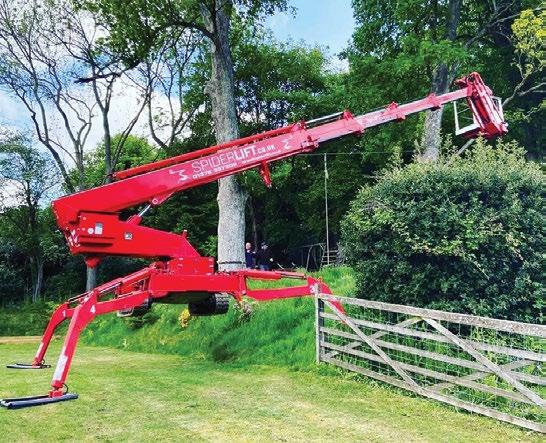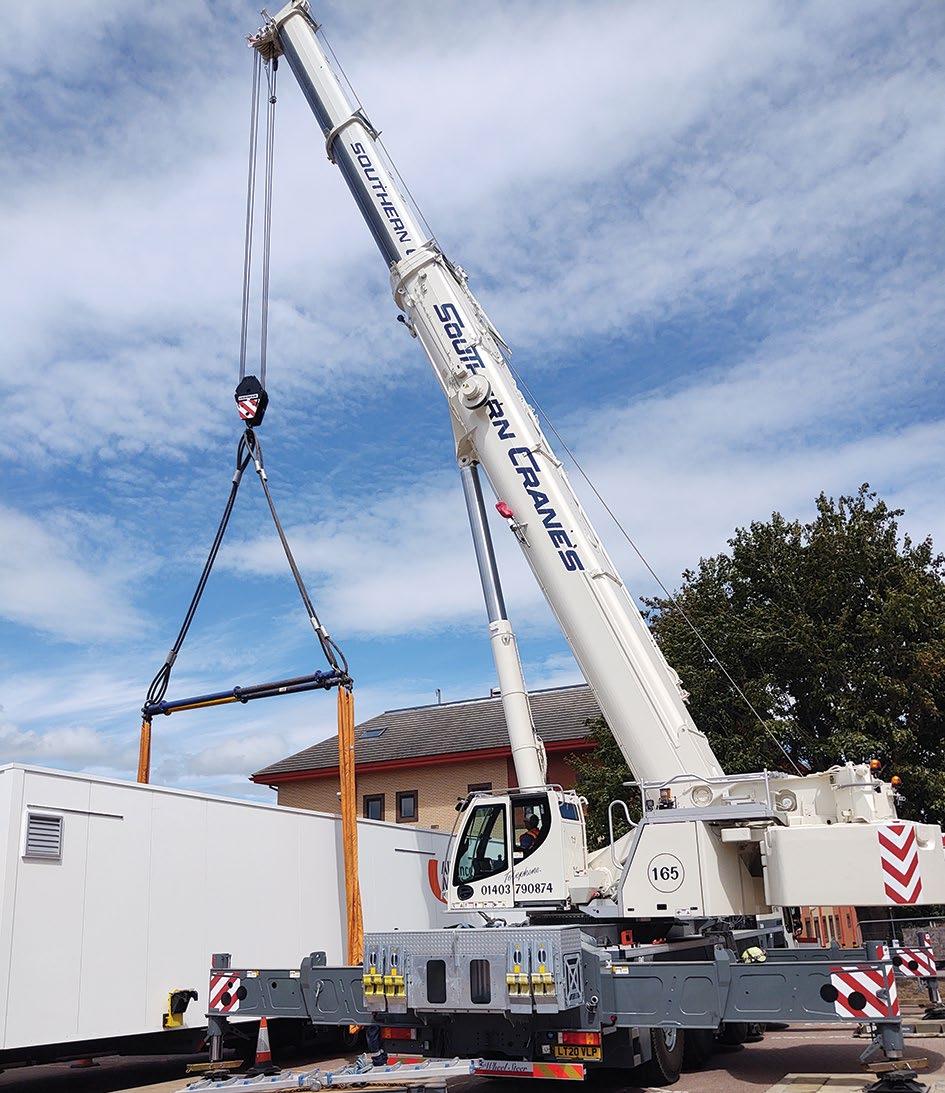
6 minute read
Spiderlift on the up
When it comes to spider lift pioneers, Peter and Lucy Ashburner of Higher Access have to be strong contenders. Established in 2006, the two of them spent the next 10 years expanding their fleet until it was the largest in Europe, helping promote the concept and put the product on the map along the way. The company was eventually purchased by UK rental group Vp in 2016 and unfortunately both Peter, and more recently Lucy, have now left the industry. One company that is hoping to carve out its own path is UK's Spiderlift - formerly MBS Access. We sat down with coowner Ben Dobson to find out how the company has evolved from a grounds maintenance company into the largest independent spider lift rental company in the UK.

“When we started out the only other independent spider lift company was Higher Access,” said Dobson. “Baker Access had just sold up and I remember thinking whether the market was big enough for two specialist companies to compete. We didn’t have the reputation, budget or infrastructure that Higher Access had, but we had the belief we could make it work.”
The business was established in 2006 when Martyn Bass purchased five Teupen spider lifts originally for his grounds and tree care business - MBS Grounds Maintenance - but later also on a rehire basis. Over time, as demand for spider lifts began to increase, it reached a point where the constant rehire of spider lifts was detracting from Bass’ core business, so in 2014 Bass and Dobson formally set up MBS Access as a stand alone company.

Dobson explains: “The timing of MBS Access proved to be very fortuitous. I had been responsible for the spider lift division at Facelift and was put in touch with Martin early on to rehire his spider lifts. In 2014 Facelift made the decision not to focus on spider lifts anymore however and almost to the day I had a call from Martyn saying he would be unable to rehire his spider lifts as he needed to concentrate on his maintenance company. Spotting an opportunity which could work for both of us, we got together, and MBS Access was born.”
Since then the company has expanded the fleet to 45 spider lifts with working heights from 11 to 42 metres. In 2018 the company acquired the Spiderlift trade name from Steve Hadfield, who had used it for his rental company before selling out to Lifterz in 2014 when he became the UK distributor of CMC.

Dobson added: “As MBS Access we were lost in a sea of general access rental companies. The Spiderlift brand was always a good name in the industry and it perfectly summed up our business - like Ronseal, we do ‘exactly what it says on the tin’. Now if someone finds us they are finding us for the right reasons.”
The company is currently enjoying a sustained period of growth, having moved into larger premises close to its original base in Essex earlier this year as well as opening a second depot in Barnsley in order to better service the north of the UK. It is also in the process of adding a further 20 lifts by mid- 2021, which will take the fleet up to 65 units.
Bolt-on product?
When asked about full-line access rental companies adding spider lifts to their fleet Dobson said: “A lot of companies are starting to bolt-on spider lift rental to their access businesses - mostly because they are spending a lot of money on rehire. However they often don’t realise just how much time and effort that goes into offering spider lifts. It’s not a ‘drop and run’ product like other platforms, the delivery and hand over is completely different, not to mention having to take machines through doorways, drive them up staircases, or dismantle them in order for them to be lifted through a skylight etc…”

Spiders for arborist
Ever since MBS Grounds Maintenance acquired its first Teupens the company has worked closely with tree surgeons with both learning a great deal from each other.
“When it comes to delivering a machine to the arb sector it is often on the boundary of a property. The first thing we ask is where is it being used and walk the route with the customer. As well as helping them identify various hazards and considerations, we are also able to offer our advice in terms of location and set up to get the most from the machine. We then provide a hand over to the person who will operate the machine before speaking to the rest of the team to ensure they are familiar with emergency lowering procedures – which have to be straight forward. If we struggle to understand how it functions how can we expect others who are less familiar with powered access and who have a hundred other things to concentrate on?”
Dobson still thinks there is a way to go however: “Tree surgeons as an industry are still learning what spiders can do and the correct way of using them. Most will have a tree that’s 30ft high so will get 30ft spider lift. What they need to take into consideration however is the drop zone. They will require a much larger machine to prevent logs being dropped onto a platform that is keeping them safe in the air. They also have this idea in their head that they can just climb out of the basket if it goes wrong and it takes a lot of work to inform them that this isn’t an option!”

“We often get sent a picture of the tree, but the reality is the tree is just one aspect of the job. The other aspects that arborists need to consider is getting the spider lift to and from the tree. Walking the route, the ground, the set up area, looking for any restrictions or concerns, anything that might be concealed or underground.”
Urban vs rural
“Generally, I class tree surgeons in two categories: urban, which do a lot of residential and parks etc… and the more commercial tree surgeons which carry out forestry work. Each one will require a different machine. The urban arborist will need a smaller, slim, compact machine to navigate gates, pathways etc… whereas the rural tree surgeon will need one that can safely traverse rough terrain. It might not have restrictions on width as they work in a more open environment.
Spiders for arb work
“When we buy spider lifts, we always look for a simple to use machine that has a clear process to go from transport mode to setting up and being operational. We also look for features that benefit the customer. Height and width adjustable tracks to offer greater ground clearance and stability over rough terrain. Whether the basket is mounted underneath or flush with the bottom will also ensure it doesn’t catch on branches. Same applies for hoses, hydraulics and cat-tracks making sure they are all enclosed. If any of these are exposed these can get caught up in the tree, break the cat-track or split a hose. Belly pans are also important as sometimes it’s not getting on to site that causes problems but when leaving. We have had a few examples when a tree has been cut down and the spider lift has been tracked over the stump, catching the underside and causing all sorts of problems.”
Recommendations
“If I was getting a spider purely for arb work the number of suitable manufacturers diminishes considerably. Teupen’s Leo 23 and Leo 30T are very popular in the tree industry, great ground clearance, very sturdy but the larger models are not always the shortest on the market. CMC has its HD range for tree surgeons as well as its new range of hydraulic models. Platform Basket also has its 18.90 while Hinowa’s 20.10 and 26.14 models are solid performers.”










